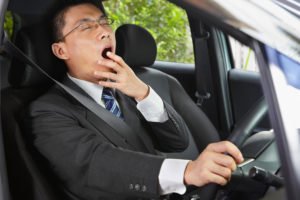Driver safety
How to tackle driver fatigue
Sleep is not a process we can fight, according to Marcus de Guingand from Third Pillar of Health.

It is estimated that fatigue is a factor in 20% of accidents on UK roads however, when the public is asked to name their top five road risks, it barely gets a mention. Fatigue-related accidents also tend to be more severe because someone who has fallen asleep at the wheel has no time to take any corrective action to minimise the potential effects.
Sleep is not a process we can fight. We will go through several indicators that we are at risk of falling asleep at the wheel – commonly called a microsleep. These can last a fraction of a second up to two to three seconds. At 56 miles per hour your vehicle will travel 25 metres per second and you will have no control over the vehicle. Remember you have no control over when your need for sleep manifests in this way. Perhaps you get lucky and your incident happens on a straight, quiet country road. What if you are not so lucky and it happens on a motorway when traffic is rapidly coming to a halt up ahead, or worse still outside a school or busy pedestrian area. It doesn’t bear thinking about.
Employers and individuals need to give serious consideration to driver fatigue. The repercussions and costs are potentially severe. There needs to be a zero tolerance approach to driver fatigue. Drivers also need to be given help and education on how to identify the signs and effective countermeasures to combat fatigue. The company also needs to have clear policies and procedures and a fair culture that aims to help drivers and not punish them.
Signs of driver fatigue
- Frequent yawning;
- Eyelids drooping / feeling heavy;
- Not remembering the last few miles driven;
- Frequently hitting the rumble strips;
- Nodding head and possibly jerking awake.
Too often we may try to combat driver fatigue by: winding down the window, turning up the music, changing lanes more frequently, adjusting the seat so it’s uncomfortable, stopping for a quick walk or to splash cold water over our face. The problem is in laboratory test none of these countermeasures were proven to be effective.
How to tackle driver fatigue
So what countermeasures are effective? We’ll start with the best first:
- Ensure you obtain sufficient good quality sleep prior to a journey;
- Avoid driving in the early morning (especially between 2am and 6am) when our alertness is naturally at its lowest;
- Take a nap before you set off;
- Change drivers – assuming you have a 2nd driver and providing they’re awake;
- Drink a caffeinated drink and immediately have a 15 to 20 minute nap;
- Pull over to a roadside hotel or somewhere safe and secure to have a longer sleep.
Driving whilst tired is simply too risky from a safety, financial and legal perspective. Don’t turn a blind eye to this common problem. It doesn’t have to be exhaustively expensive to start to tackle.
How to tackle driver fatigue
Sleep is not a process we can fight, according to Marcus de Guingand from Third Pillar of Health.
Safety & Health Practitioner
SHP - Health and Safety News, Legislation, PPE, CPD and Resources
Related Topics
Horticulture company fined after lorry driver suffers life changing injuries
Beyond Blue Monday
Top three areas to improve driver safety revealed in study

